Re-writing the book on primate care
Posted on Friday, July 22nd, 2022
This past March, the Cleveland Zoological Society hosted an event where guests learned first-hand just how special the birth of baby gorilla Kayembe was to our Zoo. At the sold-out Tails + Cocktails presented by The Steffee Family, attendees laughed, cried, and gave a standing ovation to our dedicated animal care team after getting a glimpse of what really happens behind-the-scenes preparing for and managing a monumental birth. With about 350 gorillas in accredited zoos in the U.S., what made the October 2021 birth of a baby gorilla in Cleveland so extraordinary?
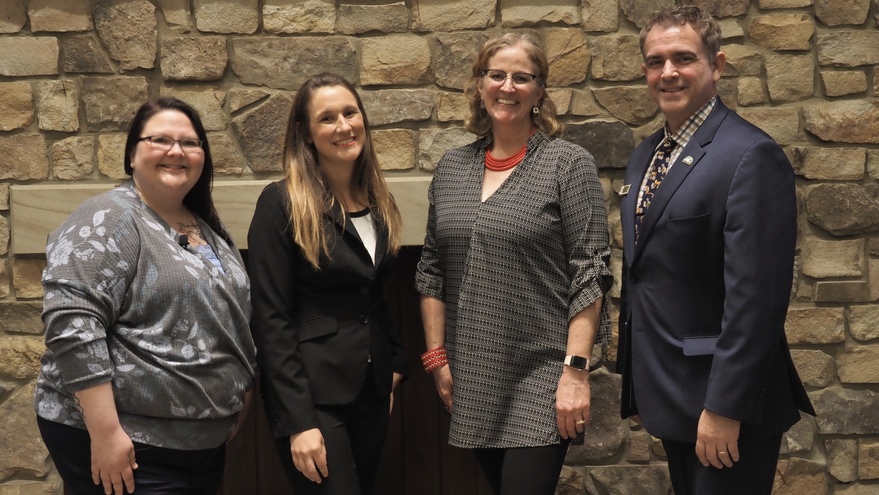
Laura Klutts, Dr. Elena Less, Dr. Kristen Lukas, and Dr. Chris Kuhar at Tails + Cocktails in March.
As a national leader in gorilla management, Cleveland Metroparks Zoo is essentially re-writing the book on primate care.
Here are the top five reasons Cleveland is the place to be when talking about gorillas.
1. Kayembe really is extraordinary
In 2021 there were only four gorilla babies born in accredited zoos in North America – two boys and two girls. Our Kayembe – whose name means “extraordinary” - is certainly special considering there are only three others his age on the continent. And since his birth, the troop has exceeded expectations in both the training leading up to his arrival and the care they showed toward the new addition.
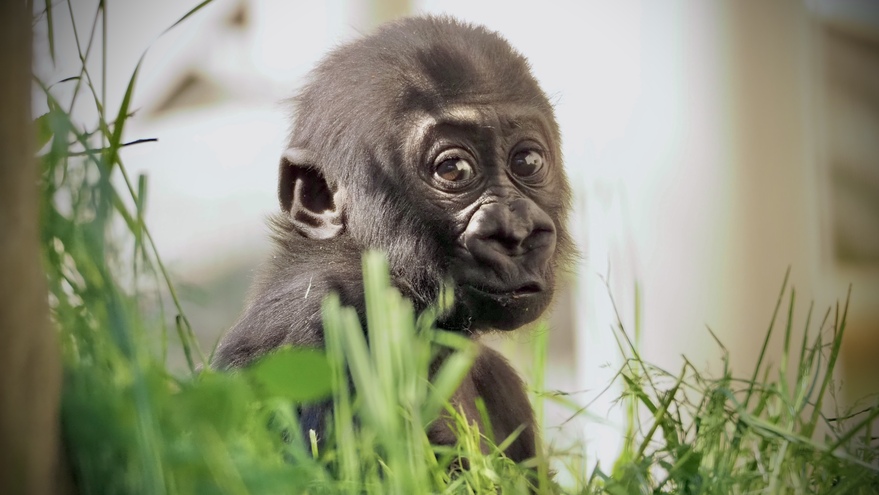
Kayembe is the newest addition to the troop.
According to Dr. Chris Kuhar, Zoo Executive Director, this birth is the first time a gorilla in any zoo has acted as a surrogate mom from the first day. Fredrika picked up baby Kayembe shortly after realizing his birth mom, Nneka, was not going to take care of him. Fredrika has continued to be primary care giver, although as Kayembe gets older and can move on his own, he is beginning to interact with the other females and even Mokolo – an important development step that will help teach Kayembe how to be a male gorilla and lead a troop of his own one day.
The bond between Fredrika and the baby is so strong that she has started lactating – an amazing scientific feat that has not been documents in gorillas as old as Freddy. As a 47-year-old female who has had a hysterectomy, and did not birth baby Kayembe,it was very unexpected.
Dr. Elena Hoellein Less, Associate Curator of Animals in the Primate, Cat & Aquatics building and a recognized expert on gorilla husbandry and behavior, said at Tails + Cocktails that the animal care team noticed Kayembe was drinking fewer ounces of his morning bottle. His behavior, however, was positive and he was not exhibiting fussiness or signs of hunger. It was concerning at first, but then the team noticed Freddy was lactating and likely nursing Kayembe overnight and between bottles.
Birth mom Nneka was involved in her own way. The team trained her to come to the mesh and use a human breast pump, so during those first few weeks of Kayembe’s life he was receiving a blend of human preemie baby formula and colostrum from Nneka. This trained behavior has not been done in zoos before, to our knowledge.
From the first day, Kayembe and the troop were behaving in ways the gorilla Species Survival Plan committee and our animal care team had only hoped would happen, and as Kayembe continues to age and the troop adjusts to having a rambunctious toddler on their hands, we will learn more about troop dynamics and caring for a young gorilla.
2. Our gorillas are among the most-studies gorillas in zoos
Scientists at Cleveland Metroparks Zoo research animal welfare, diet and husbandry of a variety of species each year, and their findings are shared with zoos globally and often published in national research publications. So look no further than Cleveland to read about groundbreaking gorilla research. Here are just a few noted studies:
GORILLA BACHELOR GROUPS
In the wild, a male gorilla usually lives with a group of several females. However, with equal numbers of male and female gorillas typically born in zoos, placing gorillas in similar social breeding units unavoidably means that some males need to live in bachelor groups. That was the case in Cleveland when our silverback Mokolo arrived in 1994. Fortunately, Dr. Kristen Lukas had a particular interest in the formation and success of bachelor groups from a variety of perspectives including behavior, physiology, and personality – leading to extensive research on the topic. Dr. Lukas is the Zoo’s Director of Conservation and Science, chair of the Gorilla Species Survival Plan (SSP) for the Association of Zoos and Aquariums, and chair of the Gorilla Saving Animals from Extinction (SAFE) program. At Tails + Cocktails, Dr. Lukas mentioned that “the troop in Cleveland was one of the longest lasting gorilla bachelor groups” in any zoo until Bebac passed away in 2017. Our troop dynamic has changed quite a bit since then, and now consists of Mokolo, four adult females, and baby Kayembe, but the research done on our bachelor group has been widely documented.
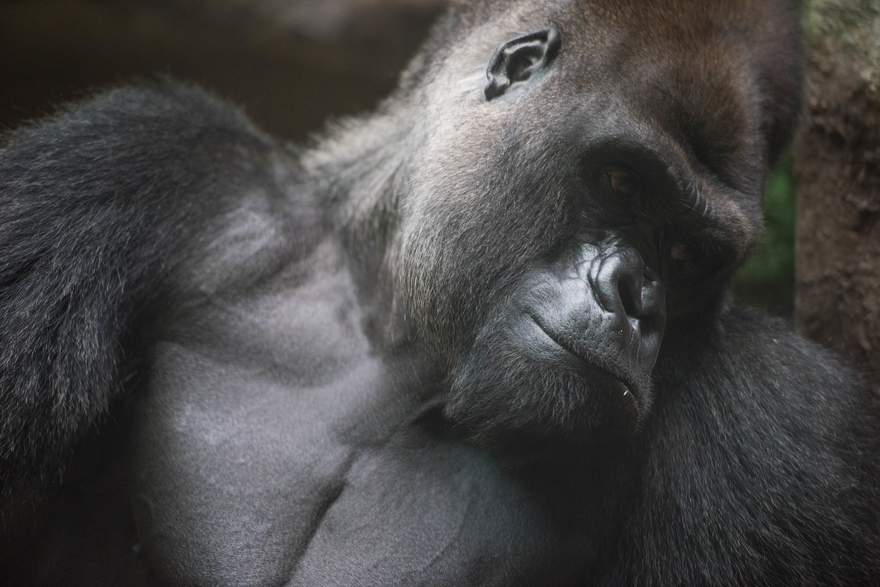
Western lowland gorilla Mokolo has been in Cleveland since 1994.
HEART DISEASE AND GORILLAS
Heart disease is another big research project led by Zoo epidemiologist Dr. Pam Dennis and colleagues. Our team launched groundbreaking work on gorilla heart health, training Mokolo to do voluntary blood draws and ultrasounds to regularly monitor his cardiac health. The research was instrumental to the creation of the Great Ape Heart Project in 2010. The Great Ape Heart Project aims to better understand cardiovascular disease in great apes. Zoos around the country contribute data and research to this project for the use of zoos worldwide. Just as Cleveland is world-renowned for human health care, the same goes for gorilla health as well.
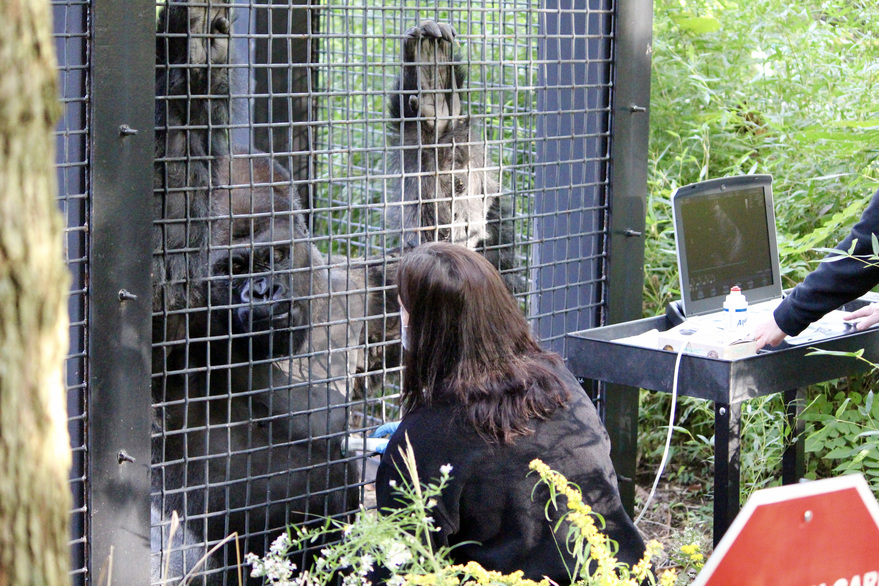
Mokolo doing a voluntary ultrasound with keepers.
THE GORILLA DIET
Dr. Elena Less started studying gorilla diets as a graduate student. She and her colleagues observed many abnormal behaviors in zoo gorillas not found in wild gorillas, mainly regurgitation and reingestion. Her research led to the introduction of a low starch biscuit-free diet, along with adding more leafy green vegetables and encouraging more foraging behaviors as gorillas would do in the wild. Guests can see this behavior when they visit the gorillas at Primate, Cats & Aquatics Building. Dandelion greens, kale and romaine are often visible throughout the habitat and in enrichment devices that make the apes have to find food as they would in the wild. These changes have had a positive impact on the overall health of gorillas in Cleveland and around the country. After changing Mokolo’s diet, Dr. Less said the regurgitation behavior stopped entirely in our gorillas.
HORMONE STUDIES IN GORILLAS
The research team in Cleveland keeps an eye on two hormones in particular, both found in Mokolo’s urine: oxytocin and cortisol. Oxytocin is a hormone that helps facilitate social bonding. Measuring Mokolo’s oxytocin levels allowed graduate students the opportunity to understand how Mokolo is viewing his social environment. By measuring cortisol, they can better understand how he handles stress. Since Mokolo has been in Cleveland, we have been able to measure his hormone levels while he was in a bachelor group, while he was transitioned into a more traditional social group with four females, and now as a first-time dad. “Because of Mokolo, we’ve had this amazing opportunity to do this research,” said Dr. Less. “He’s an ambassador for his species and we’ve learned so much from him.”
GORILLA BIRTHING PLANS
The newest research is developing as we speak. From creating a gorilla birth plan (we’re talking pages and pages), to dealing with a premature birth, to having the first surrogate gorilla mom in a zoo, we’re documenting new information and will no doubt be sharing it with zoos nationwide.
Needless to say, if you’re browsing through the archives of the American Journal of Primatology, Zoo Biology, or Primates – you’ll find our scientists at Cleveland Metroparks Zoo are at the forefront of gorilla research and highly respected in the Zoo world.
3. We are experts in behavioral training
When preparing for a gorilla birth, staff submitted a birth plan to the Gorilla SSP (Species Survival Plan) for review. Dr. Less mentioned the SSP felt our plan was rather ambitious – and they suggested only three learned behaviors would be an average amount. However, animal keeper Laura Klutts said proudly at Tails + Cocktails that our gorillas learned 14 of the behaviors.
Klutts explained that training started two years in advance of a breeding recommendation and included behaviors such as bringing the baby (a plush baby in this case) to the mesh so Zoo vets could do medical checks and keepers could bottle feed the baby if needed. This learned behavior paid off when birth mother Nneka did not show adequate maternal care and did not nurse Kayembe. Freddy learned this, too, because of this training, which came in handy when she became the surrogate mom.
When Kayembe was in human care for a few weeks, the team trained him to hang on a mesh panel during feedings, which mimicked the behavior he would need to hang onto Freddy when he was strong enough to return to the troop. Today guests may catch a glimpse of Kayembe scaling the mesh paneling in the habitat – with Freddy keeping a watchful eye – as he continues to gain strength and move more on his own. To our knowledge, Cleveland was the first to experience some of these training behaviors and the positive results. Now, as the team re-writes the book on primate care – we can share it with other zoos and husbandry efforts everywhere may benefit.
4. Cleveland is committed to gorilla conservation
The promise to help gorillas does not stop at the Zoo. Mokolo and Kayembe are just one part of the bigger story – the commitment of saving endangered gorillas in the wild. Dr. Lukas said she’s “so proud the Cleveland Metroparks Zoo has made a real commitment to the mission and connecting what we’re doing here (in Cleveland) to conservation in Africa.”
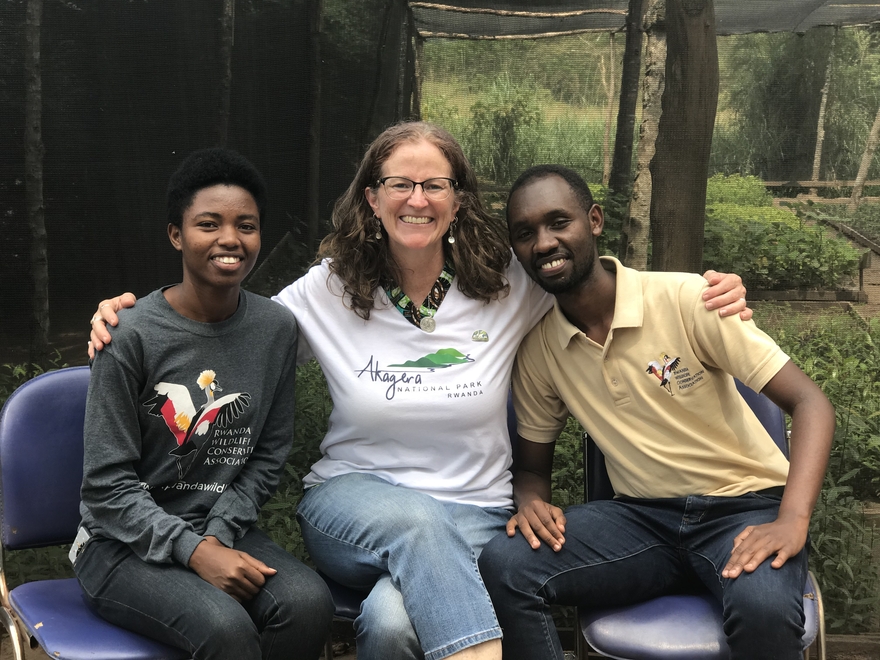
Cleveland Metropark Zoo’s Director of Conservation & Science, Dr. Kristen Lukas, with students from the University of Rwanda as part of DFGF’s Memoirs Program.
There’s a good chance, too, if you can’t find Dr. Lukas in our Conservation & Science offices, she’s in Africa. Dr. Lukas is Vice President of the Board of Directors of Dian Fossey Gorilla Fund, the Zoo’s longstanding field conservation partner working to monitor and protect gorillas in the wild. She is in Rwanda annually helping train graduate student scientists at the Karisoke Research Center; their work helps put programs in place that protect the gorillas in the area.
The new Ellen DeGeneres Campus of the Dian Fossey Gorilla Fund in Rwanda will feature the Cleveland Metroparks Zoo Interpretative Trail, a series of walking paths that highlight more than 250,000 native plants and birds, as well as sustainable building practices of the campus. Tourists from throughout the world will visit Rwanda to see gorillas in the wild and will witness this strong Cleveland connection.
5. We have a deeply invested community and donor base
Nothing showcased the support of the Cleveland community better than the gorilla baby naming contest. Over $15,000 was raised for gorilla conservation in a matter of weeks after the birth was announced. Our social media platforms were flooded with congratulatory comments about the birth, and news outlets were picking up the story both locally and nationally.
The corporate community stepped up too, including CrossCountry Mortgage, who provided a lead gift to support the building of Primate Forest, a 140,000-square-foot, world-class habitat that will transform and significantly expand the Zoo’s RainForest and create a new home for the Zoo’s gorillas and orangutans.
MCPc, the Old Brooklyn-based data protection company, promoted electronics recycling in celebration of Earth Day this April. With the help of MCPc and students from the Cleveland Metropolitan School District, we collected 16,000 lbs. of old electronics and kept them out of landfills.
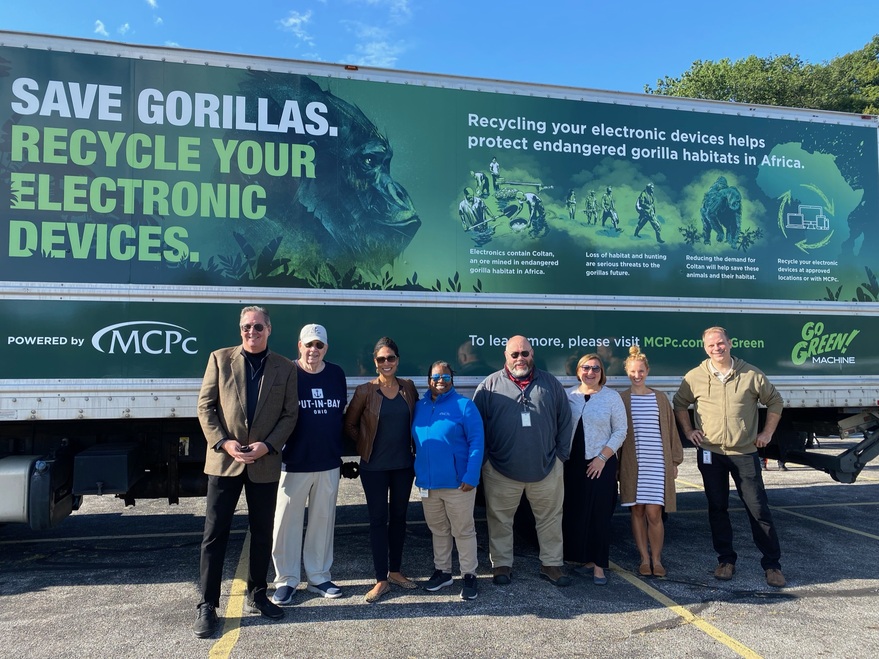
MCPc sponsored an E-recycling event at the Zoo for World Gorilla Day.
So be proud of Kayembe, the whole troop and your Zoo! Cleveland Metroparks Zoo is THE leader in animal care and welfare with a very distinct expertise in gorillas. We hope you will continue to support us through your membership, by making a donation, advocating for wildlife conservation, and sharing our story about the primates in our care.


